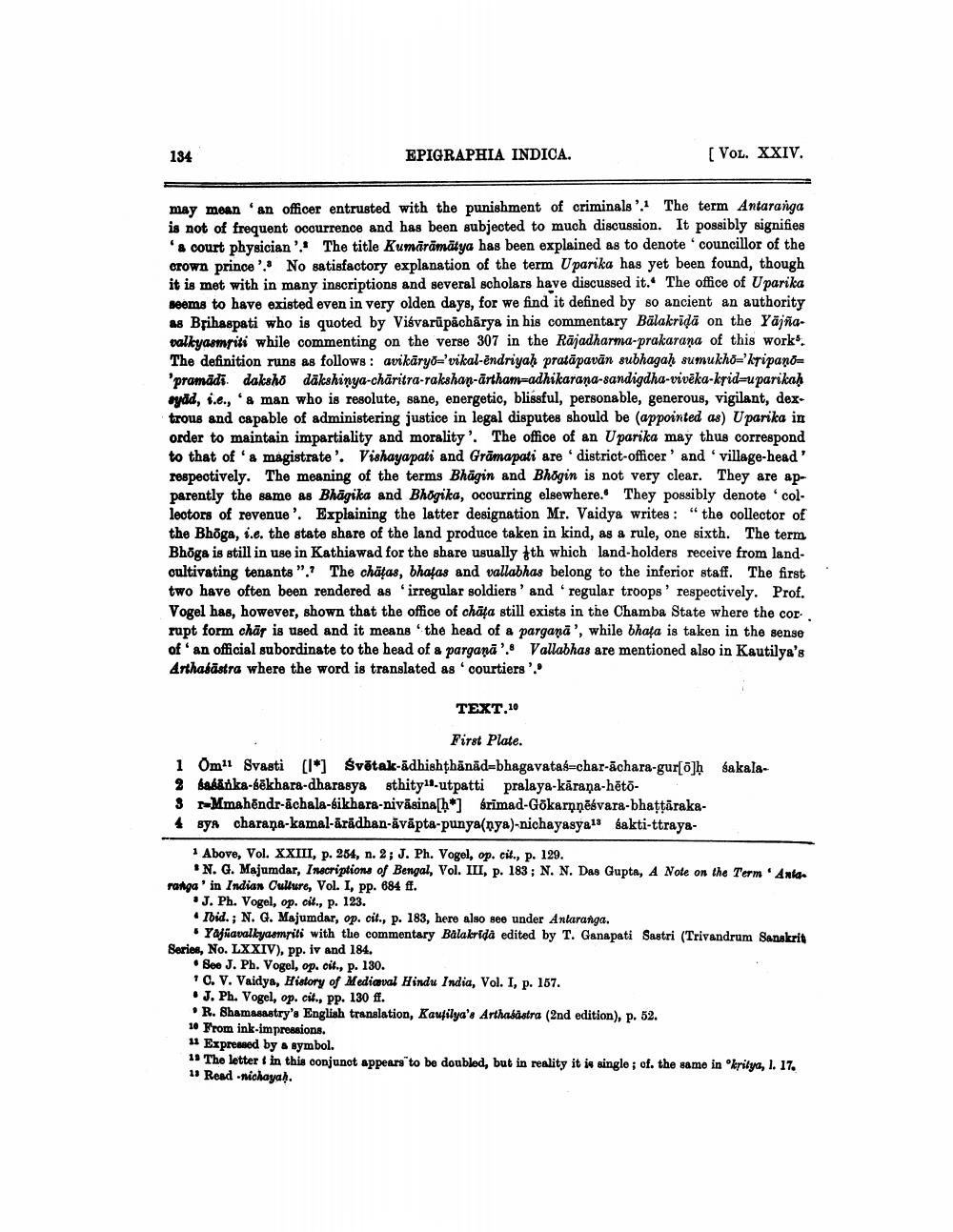________________
134
EPIGRAPHIA INDICA.
(Vol. XXIV.
may mean an officer entrusted with the punishment of criminals'. The term Antaranga is not of frequent occurrence and has been subjected to much discussion. It possibly signifies '& court physician'. The title Kumārāmātya has been explained as to denote councillor of the crown prince': No satisfactory explanation of the term Uparika has yet been found, though it is met with in many inscriptions and several scholars have discussed it. The office of Uparika seems to have existed even in very olden days, for we find it defined by so ancient an authority as Brihaspati who is quoted by Visvarūpāchārya in his commentary Balakrīdā on the Yājñavalkyasmriti while commenting on the verse 307 in the Rājadharma-prakarana of this works. The definition runs as follows: avikāryo="vikal-endriyah pratāpavān subhagah sumukhô='kripano pramadi daksho dakshinya-chäritra-rakshan-artham-adhikarana-sandigdha-vivēka-kridau parikah sydd, i.e., & man who is resolute, sane, energetic, blissful, personable, generous, vigilant, dextrous and capable of administering justice in legal disputes should be (appointed as) Uparika in order to maintain impartiality and morality'. The office of an Uparika may thus correspond to that of a magistrate'. Vishayapati and Grāmapati are district-officer' and 'village-head' respectively. The meaning of the terms Bhagin and Bhögin is not very clear. They are apparently the same as Bhägika and Bhogika, occurring elsewhere. They possibly denote collectors of revenue'. Explaining the latter designation Mr. Vaidya writes : "the collector of the Bhöga, i.e. the state share of the land produce taken in kind, as a rule, one sixth. The term Bhöga is still in use in Kathiawad for the share usually th which land-holders receive from landoultivating tenants ".? The chātas, bhatas and vallabhas belong to the inferior staff. The first two have often been rendered as irregular soldiers' and regular troops' respectively. Prof. Vogel has, however, shown that the office of chāļa still exists in the Chamba State where the cor. rupt form chăr is used and it means the head of a parganā', while bhafa is taken in the sense of an official subordinate to the head of a parganā '.8 Vallabhas are mentioned also in Kautilya's Arthasāstra where the word is translated as courtiers'
TEXT.10
sakala
First Plate. 1 Omli Svasti [l*] Svētak-ādhishthänād=bhagavatas-char-āchara-gur[7]h
gasänka-bēkhara-dharasya sthity 11.utpatti pralaya-kāraņa-hēto3 Mmahēndr-achala-sikhara-niväsina[h*] Srimad-Gökarnnēsvara-bhattaraka4 sya charana-kamal-ärädhan-āvāpta-punya(nya)-nichayasyal sakti-ttraya
1 Above, Vol. XXIII, p. 264, n. 2; J. Ph. Vogel, op. cit., p. 129.
.N. G. Majumdar, Inscriptions of Bengal, Vol. III, p. 183; N. N. Das Gupta, A Note on the Term Anton ranga' in Indian Culture, Vol. I, pp. 684 ff.
•J. Ph. Vogel, op. cit., p. 123. • Ibid. ; N. G. Majumdar, op. cit., p. 183, here also see under Anlaranga.
Yafiavalkyaompiti with the commentary Balakrida edited by T. Ganapati Sastri (Trivandrum Sanskrit Series, No. LXXIV), pp. iv and 184.
• See J. Ph. Vogel, op. cit., p. 130. +0. V. Vaidya, History of Mediaval Hindu India, Vol. I, p. 157. . J. Ph. Vogel, op. cit., pp. 130 ff. .R. Shamasastry's English translation, Kautilya'. Arthasästra (2nd edition), p. 52. 10 From ink-impressions. 11 Expressed by a symbol. 11 The letter 1 in this conjunot appears"to be doubled, but in reality it is single ; of the same in krilya, I. 17. 11 Read -nichayah.




